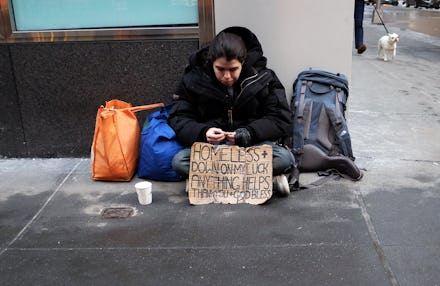This Map Shows Every State Where Women Are More Likely to Live in Poverty Than Men

The Institute for Women's Policy Research released a report Wednesday noting the U.S. states in which women are more likely than men to live in poverty and less likely to own a business. Those states are marked below in pink:
Hold on. That can't be right — every state is colored in.
Unfortunately, the map is accurate. According to the report, "Status of Women in the States: 2015," even though women are outperforming men, across races, in education and health care coverage, they still own fewer business and tend to be poorer.
And it's especially problematic for millennial women, who are much more likely to have a bachelor's degree or higher than millennial men, but who are consistently earning less and living in poverty more.
Only 17.6% of men without children live in poverty, whereas the number for childless women is 20.9%. The most disheartening statistic in the study reveals that the most likely demographic to live in poverty is single mothers, with an astonishing 43.1% living below the poverty line.
What are we doing so wrong? One of the big problems the report reveals isn't just about gender inequality — it's just as much about racial inequality.
Roughly 1 in 3 Hispanic women have less than a high school diploma, as opposed to only 7.9% of white women. Additionally, 48.4% of Asian/Pacific Islander and 32.5% of white women have a bachelor's degree or higher, compared with 15.5% of Native American and 21.6% of black women.
Less than 30% of businesses in this country are owned by women and, even then, the IWPR report states: "Women-owned businesses are concentrated in industries where firms are usually smaller and have smaller sales/receipts than the industries in which men-owned businesses are concentrated. The average sales/receipts for women-owned businesses in the United States are about one-fourth of the average sales/receipts for men-owned businesses."
The report doesn't cover other factors that make women more vulnerable economically, such as domestic violence. The Huffington Post reports that 8 million paid work days are lost to abuse, which is equivalent to roughly 32,000 full-time jobs. Not tackling this problem head on is literally costing millions of dollars.
What can we do to make it right? The most obvious change to make would be to mandate equal pay. This would cut the poverty rate for working women by half. Women are still only earning 78 cents to every man's dollar.
"Using 2012 data, the amount of income that women would gain if women were paid the same amount as men would amount to just under 450 billion dollars which is about 3% of 2012 GDP," Jessica Milli, co-author of the latest report, told Mic. "That is about 14 times the amount of money that was spent by federal and state governments on welfare."
Public policies that ensure a social safety net, such as Obamacare, are all essential to reducing inequality and protecting the vulnerable. After the Affordable Care Act, uninsured women between 18 and 24 years old fell from 24.9% to 15.9%, according to the report.
Specifically, pregnant workers' rights need to be addressed. Legislative Counsel from the American Civil Liberties Union, Vania Leveille, spoke to Mic about the importance of such rights.
"It can have a significant impact on women's ability to take care of themselves and their families. I think President Obama said it well: 'When women succeed, America succeeds.' No woman should have to choose between supporting her family and a healthy pregnancy."
While there is the obvious and natural pushback from some who are in charge, who thrive in the existing system, the unwillingness to protect those susceptible to disadvantage is myopic. Inequality is literally costing America millions of dollars and we can only excel in a sustained way once everyone is on a level playing field.